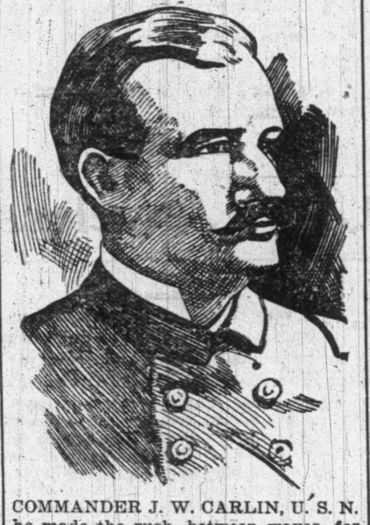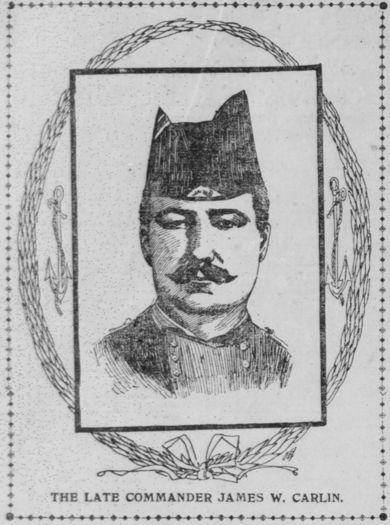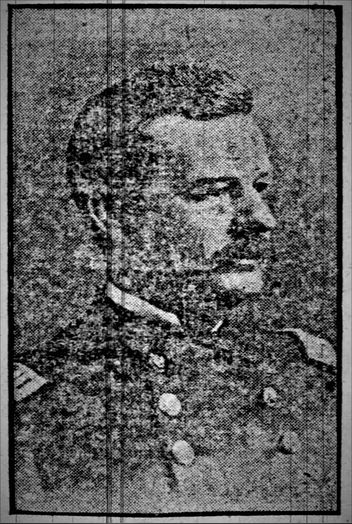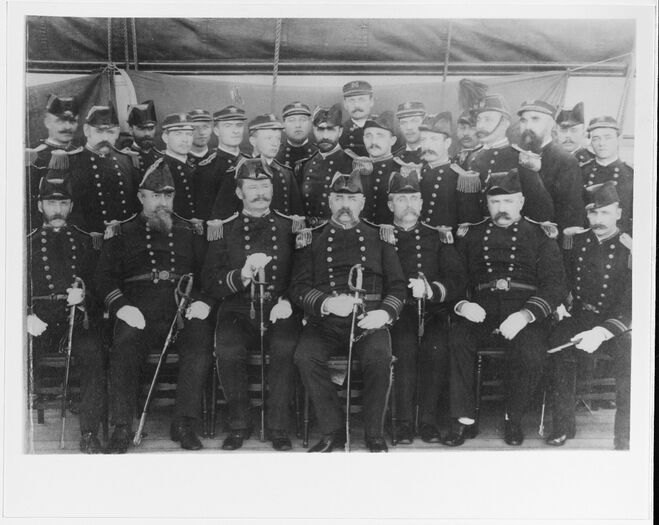JAMES W. CARLIN, CDR, USN
James is currently listed with his classmates in Memorial Hall. However, we have recommended to the Memorial Oversight Committee at the US Naval Academy that he be removed for the reason listed at the bottom of this page; his loss was not due to hostile action or the result of his military duties.
His entry remains below so we do not lose his memory or the knowledge of his life and service.
James Carlin '68
James William Carlin was admitted to the Naval Academy from Illinois on July 23, 1864 at age 16 years 2 months.
Prior to the publication of the Lucky Bag in 1894, most portraits of officers and midshipmen of the Naval Academy were captured in yearly photo albums. The album for 1868 is available in the collections of the Naval Academy's Digital Collections.
Special thank you to historian Kathy Franz for identifying this resource and then extracting several dozen photographs for this site.
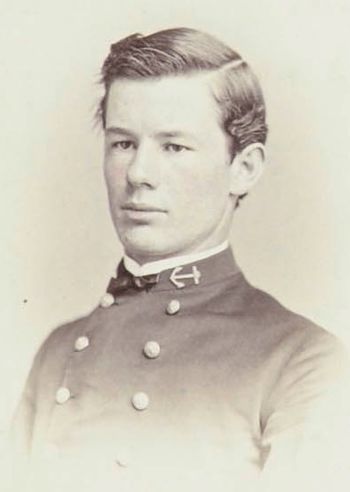
Prior to the publication of the Lucky Bag in 1894, most portraits of officers and midshipmen of the Naval Academy were captured in yearly photo albums. The album for 1868 is available in the collections of the Naval Academy's Digital Collections.
Special thank you to historian Kathy Franz for identifying this resource and then extracting several dozen photographs for this site.
Loss
James died of peritonitis on December 30, 1899 while aboard the navy ship Culgoa, enroute to the naval hospital at Yokohama. It seems he was the commanding officer.
Other Information
From researcher Kathy Franz:
In the 1860 census, James' father John was a deputy recorder in Carthage, Illinois. His mother was Martha Jane (Flood.) They married on April 6, 1843 in Adams County, Illinois. She died in 1884.
In the August 18, 1870 census, James was living with the William Flood family in Washington, D. C.
James registered to vote in San Francisco on October 18, 1892. He was 6' ¾ inches tall with brown eyes and black hair. He had a scar on his left cheek. He lived at 226 Stockton, first floor, room 9.
Rudyard Kipling's Sea to Sea
From Rudyard Kipling's From Sea to Sea and Other Sketches, Letters of Travel, published in 1889:
But this has nothing to do with San Francisco and her merry maidens, her strong, swaggering men, and her wealth of gold and pride. They bore me to a banquet in honour of a brave Lieutenant — Carlin, of the Vandalia — who stuck by his ship in the great cyclone at Apia and comported himself as an officer should. On that occasion — 'twas at the Bohemian Club — I heard oratory with the roundest of O's; and devoured a dinner the memory of which will descend with me into the hungry grave. There were about forty speeches delivered; and not one of them was average or ordinary. It was my first introduction to the American Eagle screaming for all it was worth. The Lieutenant's heroism served as a peg from which those silver-tongued ones turned themselves loose and kicked. They ransacked the clouds of sunset, the thunderbolts of Heaven, the deeps of Hell, and the splendours of the Resurrection, for tropes and metaphors, and hurled the result at the head of the guest of the evening. Never since the morning stars sang together for joy, I learned, had an amazed creation witnessed such superhuman bravery as that displayed by the American navy in the Samoa cyclone. Till earth rotted in the phosphorescent star-and-stripe slime of a decayed universe that God-like gallantry would not be forgotten. I grieve that I cannot give the exact words. My attempt at reproducing their spirit is pale and inadequate. I sat bewildered on a coruscating Niagara of—blatherumskite. It was magnificent—it was stupendous; and I was conscious of a wicked desire to hide my face in a napkin and grin. Then, according to rule, they produced their dead, and across the snowy tablecloths dragged the corpse of every man slain in the Civil War, and hurled defiance at "our natural enemy" (England, so please you!) "with her chain of fortresses across the world." Thereafter they glorified their nation afresh, from the beginning, in case any detail should have been overlooked, and that made me uncomfortable for their sakes. How in the world can a white man, a Sahib of Our blood, stand up and plaster praise on his own country? He can think as highly as he likes, but his open-mouthed vehemence of adoration struck me almost as indelicate. My hosts talked for rather more than three hours, and at the end seemed ready for three hours more. But when the Lieutenant—such a big, brave, gentle giant!—rose to his feet, he delivered what seemed to me as the speech of the evening. I remember nearly the whole of it, and it ran something in this way: "Gentlemen—it's very good of you to give me this dinner and to tell me all these pretty things, but what I want you to understand—the fact is—what we want and what we ought to get at once is a navy—more ships—lots of 'em—" Then we howled the top of the roof off, and I, for one, fell in love with Carlin on the spot. Wallah! He was a man.
The hurricane occurred in March 1899 in Samoa; he took command of USS Vandalia when Cornelius Schoonmaker '59, the commanding officer, was killed. Also lost was Francis Sutton '81.
"Ship's officers posed on deck [of Vandalia], while she was flagship of the Pacific Station, circa 1888. Photographed at Honolulu, Hawaii. Seated, left to right: Lieutenant John C. Wilson; Chief Engineer George J. Burnap; Lieutenant James Carlin '68; Captain Henry L. Howison, Commanding Officer; Paymaster Frank H. Arms; Surgeon Hosea J. Babin; and Lieutenant Charles E. Fox. Standing, left to right: Lieutenant (Junior Grade) Horace M. Witzel; Passed Assistant Engineer Alexander B. Bates; Lieutenant (Junior Grade) Thomas M. Brumby; Naval Cadet Harold K. Hines; Naval Cadet Samuel P. Edmunds; Naval Cadet Edward Moale, Jr. '87; Naval Cadet Charles E. Johnston; Naval Cadet Samuel B. Winram; Lieutenant Hawley O. Rittenhouse; Carpenter Joseph B. Fletcher; Assistant Surgeon Francis W.F. Wieber; Naval Cadet George F. Cooper; Ensign Charles Sweeting '83; Lieutenant Greenlief A. Merriam; First Lieutenant George F. Elliott, USMC; Pay Clerk John Roche; Assistant Engineer Walter M. McFarland; and Naval Cadet William G. McMillan.
Other Information
He is buried in Illinois.
Career
From the Naval History and Heritage Command:
Midshipman, 23 July, 1864. Graduated 2 June, 1868. Ensign, 19 April, 1869. Master, 12 July, 1870. Lieutenant, 12 February, 1874. Lieutenant Commander, 10 May, 1895. Commander, 3 March, 1899. Died 30 December, 1899.
The "Register of Commissioned and Warrant Officers of the United States Navy and Marine Corps" was published annually from 1815 through at least the 1970s; it provided rank, command or station, and occasionally billet until the beginning of World War II when command/station was no longer included. Scanned copies were reviewed and data entered from the mid-1840s through 1922, when more-frequent Navy Directories were available.
The Navy Directory was a publication that provided information on the command, billet, and rank of every active and retired naval officer. Single editions have been found online from January 1915 and March 1918, and then from three to six editions per year from 1923 through 1940; the final edition is from April 1941.
The entries in both series of documents are sometimes cryptic and confusing. They are often inconsistent, even within an edition, with the name of commands; this is especially true for aviation squadrons in the 1920s and early 1930s.
Alumni listed at the same command may or may not have had significant interactions; they could have shared a stateroom or workspace, stood many hours of watch together, or, especially at the larger commands, they might not have known each other at all. The information provides the opportunity to draw connections that are otherwise invisible, though, and gives a fuller view of the professional experiences of these alumni in Memorial Hall.
July 1868
January 1869
July 1870
January 1871
January 1872
January 1873
January 1874
January 1875
January 1876
July 1877
July 1878
January 1879
January 1880
July 1881
January 1882
January 1884
February 1885
January 1886
February 1887
January 1888
January 1889
January 1890
January 1891
January 1892
January 1893
July 1894
January 1895
January 1896
January 1897
January 1898
January 1899
January 1900
Memorial Hall Error
Illness is not a criteria for inclusion in Memorial Hall.
